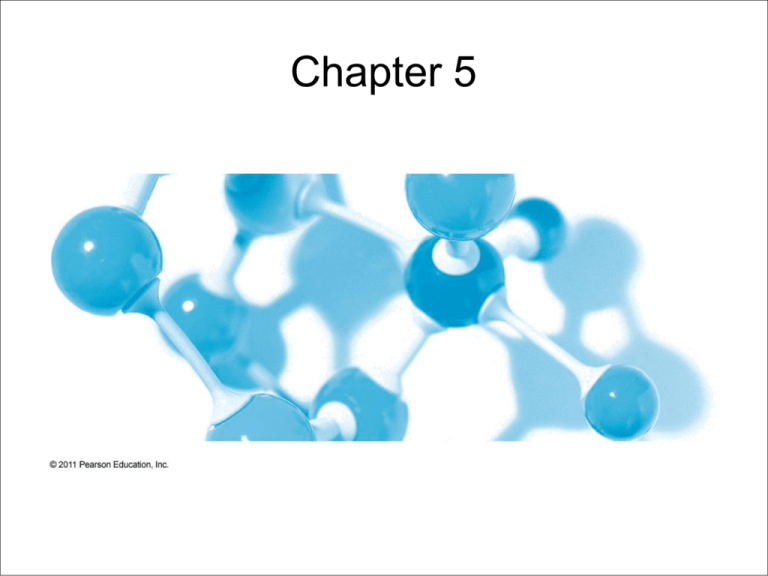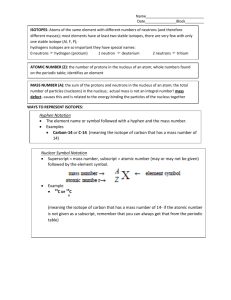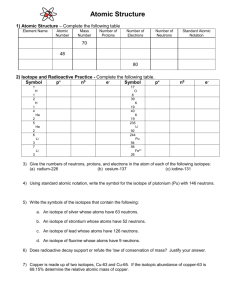ppt
advertisement

Chapter 5 Text here Atoms Atoms are the smallest particle of at element that have the properties of that element. Atoms are too small to be seen with even the most powerful optical microscope. The three major particles that make up an atom are: Protons, neutrons, and electrons Particle electrical charge mass (g) mass (amu) Location Proton +1 1.66E-24 1 nucleus Neutron 0 1.66E-24 1 nucleus 1/1839 electron cloud (orbitals) Electron -1 ● 9.03E-28 amu = atomic mass unit Most of the mass of an atom is in the small, dense nucleus. ● The radius of an atom is about 100,000 times larger than the radius of the nucleus. ● Electrons are located around the nucleus in orbitals. ● Orbitals – not distinct like planetary orbits, but 3-D regions where electrons can probably be found (“electron clouds”). ● The position of the outermost electrons determines the radius of the atom. ● Most of an atom is empty space ● An element is defined by the number of protons in its nucleus: This is called the atomic number (Z) ● The periodic table is arranged by atomic number, starting with #1 in the upper left and increasing across each period. ● ● ● Most of the mass of an atom is in the nucleus mass number (A) = protons (p) + neutrons (n) Atoms of elements are electrically neutral, so: # of electrons (e-)= # of protons (p) All atoms of an element have the same atomic number. ● All atoms of an element will therefore have the same number of electrons. ● All atoms of an element may not have the same number of neutrons, so may also have different mass numbers. ● Atoms of an element with different numbers of neutrons are called isotopes. ● Isotope Notation ● Z = atomic # = # of protons = p ● A = mass # = p + n ● Isotopes are denoted using the chemical symbol, X, or the element name: AX Z = AX = X-A = element name-A So a carbon isotope with 6 neutrons could be written as: 6 12C = 12C = C-12 = Carbon-12 Most of the mass of an atom is in the nucleus, but the actual atomic mass is not exactly the sum of the masses of the nucleons (p + n). ● The electrons do have a small mass. ● Some mass is gained/lost in the energy binding nucleons together (E = m c2) The periodic table shows the average atomic masses, in amu. These masses are the weighted averages of the masses of all of the naturally occurring isotopes. Average atomic mass = sum over all isotopes of the mass of each isotope times its fractional abundance (percentage/100): Avg. at. mass = (atomic mass)( percent abundance) Σ 100 % where “Σ” means to sum over all isotopes present For example: Lithium has two naturally occurring isotopes: Li-6 6.015 amu 7.42 % abundance Li-7 7.016 amu 92.58% abundance So, for a standard sample of lithium: avg. at. mass = (6.015 amu)(7.42 %) 100 % + ( 7.016 amu)(92.58 %) 100 % = 0.446 amu + 6.50 amu = 6.94 amu Radioactivity – spontaneous emission of radiation ● ● ● Unstable atoms – not all atoms are radioactive Radioactivity depends on number of protons and n/p ratio. Larger atomic # are more likely to be radioactive – all actinides are radioactive ● Stable nuclei have n/p close to 1 (so # n = # p) ● The n/p ratio increases for larger atomic #s There are three main types of radiation: 1) Alpha particles (α) ● Helium nuclei → 2 protons + 2 neutrons 4α ● α = 2 ● Least dangerous – stopped by paper or skin ● Dangerous if inhaled/ingested 2) Beta particles (β) ● High speed electron 0β ● β = -1 ● More dangerous – stopped by aluminum foil, usually stopped by skin ● Dangerous if inhaled/ingested 3)Gamma rays (γ) ● High energy electromagnetic radiation – more energetic than x-rays ● No rest mass or charge ● More dangerous than other radiation – may take several feet of concrete/lead to stop ● Breaks chemical bonds, damages DNA ● Gamma radiation accompanies other radioactive emissions. Radioactive Decay Series When unstable nuclei emit radiation, they change into other isotopes/elements. ● The new isotope(s) formed may also be radioactive. ● This process continues until stable isotopes are formed. ● The Decay Series is all of the isotopes formed as a radioactive element decays into stable isotopes. ● When an isotope undergoes a decay process: A very small amount of mass is lost as energy. ●But the overall mass # is conserved. ●And the nuclear charge is conserved. ● In other words: ●The mass number of the isotope should equal the sum of mass numbers of the products. ●The atomic number of the isotope should equal the sum of atomic numbers of the products. Alpha Decay – emission of an alpha particle: 92 238U → 2 4α + 90 234Th Beta Decay – emission of a beta particle: 4 10Be → -1 0β + 5 10B Gamma rays accompany radioactive decay. Neutrons may also be emitted: 1n → 0 β + 1p 0 -1 1 The half life of an isotope is the time required for half of a sample to undergo radioactive decay. ● Half lives may range from fractions of a second to millions of years. ● After one half life, half of the sample decays, after two half lives, 3/4 has decayed, ● mass of isotope remaining = (initial mass)/2x where x is the number of half lives ● Remember that, after a radioactive isotope has decayed, the new isotopes may also be radioactive. ●








